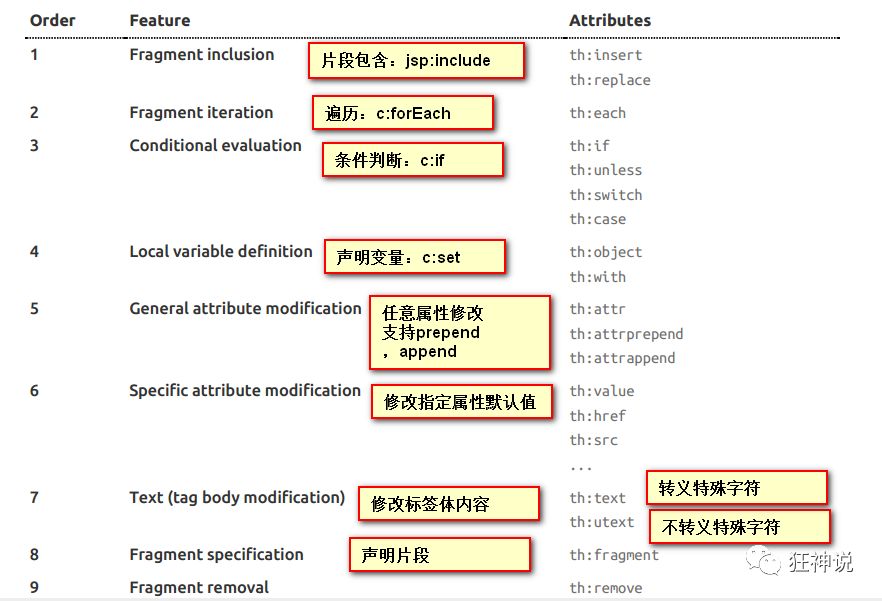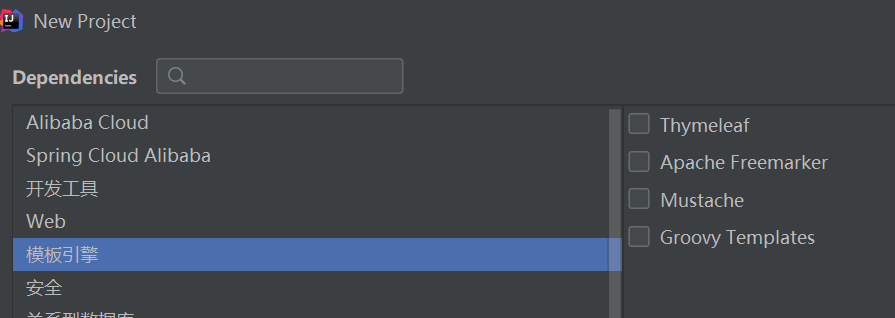SpringBoot默认是不支持jsp的,SpringBoot项目首先是以jar存在的,而不是war。
- 如果不使用jsp,则模板引擎用于弥补静态页面的不足。
- 模板引擎有很多,实际上jsp就是一个模板引擎。除此以外还有用的比较多的freemarker,springboot推荐使用的Thymeleaf…
模板引擎思想
不管是什么模板引擎,思想都是一样的
简:模板引擎对静态的页面进行渲染,将动态的数据填充
完整:我们在后台封装一些数据。然后把这个模板和这个数据交给我们模板引擎,模板引擎按照我们这个数据帮你把这表达
式解析、填充到我们指定的位置,然后把这个数据最终生成一个我们想要的内容给我们写出去
模板引擎很大程度被前后端分离替代了,模板引擎实际上是个很古老的东西了
templates目录
该目录是存放模板的(模板引擎)
**
- 在templates中的HTML页面需要被访问到,需要模板引擎的支持。在创建项目时添加相关依赖即可
引入Thymeleaf
对于springbopot来说,无论什么都是一个starter的事。我们去找到Thymeleaf的依赖即可
Thymeleaf必须导入3.?的版本,2.?的现在用不了了
有如下网址可以找到
- Thymeleaf 官网:https://www.thymeleaf.org/
- Thymeleaf 在Github 的主页:https://github.com/thymeleaf/thymeleaf
- Spring官方文档:找到我们对应的版本官方文档
<dependency><groupId>org.springframework.boot</groupId><artifactId>spring-boot-starter-thymeleaf</artifactId></dependency>
一些配置
spring.thymeleaf.cache=false #禁用模板引擎的缓存功能源码阅读
还是跟之前一样,不知道怎么使用就去找对应的自动配置类(ThymeleafProperties)
6行表示前缀,表示静态资源的路径:template@ConfigurationProperties( prefix = "spring.thymeleaf" ) public class ThymeleafProperties { private static final Charset DEFAULT_ENCODING; public static final String DEFAULT_PREFIX = "classpath:/templates/"; public static final String DEFAULT_SUFFIX = ".html"; private boolean checkTemplate = true; private boolean checkTemplateLocation = true; private String prefix = "classpath:/templates/"; private String suffix = ".html"; private String mode = "HTML"; private Charset encoding; }
7行为后缀,表示只支持HTML格式的静态资源
我们只需要把我们的html页面放在类路径下的templates下,thymeleaf就可以帮我们自动渲染了。
使用thymeleaf什么都不需要配置,只需要将他放在指定的文件夹下即可
第一个Thymeleaf
@Controller
public class TestController {
@RequestMapping("/t1")
public String test1(Model model){
//存入数据
model.addAttribute("msg","Hello,Thymeleaf");
//classpath:/templates/test.html
return "test";
}
}
Model还不清楚是什么回事。应该跟SpringMVC或者MVC有关 。
<!DOCTYPE html>
<html lang="en" xmlns:th="http://www.thymeleaf.org">
<head>
<meta charset="UTF-8">
<title>狂神说</title>
</head>
<body>
<h1>测试页面</h1>
<!--th:text就是将div中的内容设置为它指定的值,和之前学习的Vue一样-->
<div th:text="${msg}"></div>
</body>
</html>
结果
元素值不一定需要使用addattirbute来存数据,还不清楚如下代码为什么
@RequestMapping("/t2")
public String test2(Map<String,Object> map){
//存入数据
map.put("msg","<h1>Hello</h1>");
map.put("users", Arrays.asList("qinjiang","kuangshen"));
//classpath:/templates/test.html
return "test";
}
<!DOCTYPE html>
<html lang="en" xmlns:th="http://www.thymeleaf.org">
<head>
<meta charset="UTF-8">
<title>狂神说</title>
</head>
<body>
<h1>测试页面</h1>
<div th:text="${msg}"></div>
<!--不转义-->
<div th:utext="${msg}"></div>
<!--遍历数据-->
<!--th:each每次遍历都会生成当前这个标签:官网#9-->
<h4 th:each="user :${users}" th:text="${user}"></h4>
<h4>
<!--行内写法:官网#12-->
<span th:each="user:${users}">[[${user}]]</span>
</h4>
</body>
</html>
Thymeleaf语法
先添加约束
语法详见Thymeleaf官方文档,不过也没多少
要使用Thymeleaf,要在HTML中添加命名空间的约束。之前只是导入依赖只是让项目能识别templates目录。并未使用到Thymeleaf语法,所以未引入约束
xmlns:th="http://www.thymeleaf.org" 约束一般写在<html>标签这里,如:<html lang="en" xmlns:th="http://www.thymeleaf.org">取元素表达式
取数据(元素) 在HTML标签加上指令与取元素表达式即可 th:即Thymeleaf指令
指令+取元素表达式如th:text=${msg} th:text是指令 ${?}是取元素表达式 有些类似Vue
有的htm l标签不支持Thymeleaf指令 如div支持,h1不支持$变量 ${?}
- 选择变量 {?}
- @链接
国际化消息
-
字面量
文本 使用单引号包含 ‘jiang’
- 数字直接写 2
- 布尔值直接写 true false
-
运算符
- 文本连接
- 数学运算: + - * / %
- 布尔运算 and or not
- 比较运算 > < >= <= == !=
- 条件运算

1:片段包含即引入其他页面文件或者代码块文件 类似jsp的include
转义
如model.addAttribute(msg,"<h1>hello world"</h1>);
使用th:text囧会输出加大加粗的hello world 使用utext就会输出
标签
遍历
遍历是使用最多的一种
首先创建一个集合**model.addAttribute(Array.asList())**
asList作用是将数组转化为一个集合。可能也可以根据基本类型的参数创建集合**<h3>th:each="user:${users}" th:text="${user}"</h3>**th:each作用是遍历元素。users集合的元素一个一个输出到user,再通过th:text输出每一个元素
另外一种写法:<h3 th:each="user:${users}">[[${user}]]</h3> 这种是利用了转义
th:each实际上就是for-each
完整汇总及用法
Simple expressions:(表达式语法)
Variable Expressions: ${...}:获取变量值;OGNL;
1)、获取对象的属性、调用方法
2)、使用内置的基本对象:#18
#ctx : the context object.
#vars: the context variables.
#locale : the context locale.
#request : (only in Web Contexts) the HttpServletRequest object.
#response : (only in Web Contexts) the HttpServletResponse object.
#session : (only in Web Contexts) the HttpSession object.
#servletContext : (only in Web Contexts) the ServletContext object.
3)、内置的一些工具对象:
#execInfo : information about the template being processed.
#uris : methods for escaping parts of URLs/URIs
#conversions : methods for executing the configured conversion service (if any).
#dates : methods for java.util.Date objects: formatting, component extraction, etc.
#calendars : analogous to #dates , but for java.util.Calendar objects.
#numbers : methods for formatting numeric objects.
#strings : methods for String objects: contains, startsWith, prepending/appending, etc.
#objects : methods for objects in general.
#bools : methods for boolean evaluation.
#arrays : methods for arrays.
#lists : methods for lists.
#sets : methods for sets.
#maps : methods for maps.
#aggregates : methods for creating aggregates on arrays or collections.
==================================================================================
Selection Variable Expressions: *{...}:选择表达式:和${}在功能上是一样;
Message Expressions: #{...}:获取国际化内容
Link URL Expressions: @{...}:定义URL;
Fragment Expressions: ~{...}:片段引用表达式
Literals(字面量)
Text literals: 'one text' , 'Another one!' ,…
Number literals: 0 , 34 , 3.0 , 12.3 ,…
Boolean literals: true , false
Null literal: null
Literal tokens: one , sometext , main ,…
Text operations:(文本操作)
String concatenation: +
Literal substitutions: |The name is ${name}|
Arithmetic operations:(数学运算)
Binary operators: + , - , * , / , %
Minus sign (unary operator): -
Boolean operations:(布尔运算)
Binary operators: and , or
Boolean negation (unary operator): ! , not
Comparisons and equality:(比较运算)
Comparators: > , < , >= , <= ( gt , lt , ge , le )
Equality operators: == , != ( eq , ne )
Conditional operators:条件运算(三元运算符)
If-then: (if) ? (then)
If-then-else: (if) ? (then) : (else)
Default: (value) ?: (defaultvalue)
Special tokens:
No-Operation: _


